
Highlight: Lavish Bhutan wedding with sacred religious traditional blessing, photography, Bhutanese traditional costumes, blessing by buddhist masters, special ceremony in a sacred ancient temple.Bhutan tour and wedding photography.
Description : Bhutan has a unique cultural heritage which has its roots in Buddhism. The Bhutanese people have successfully kept its culture and traditions intact until this day.
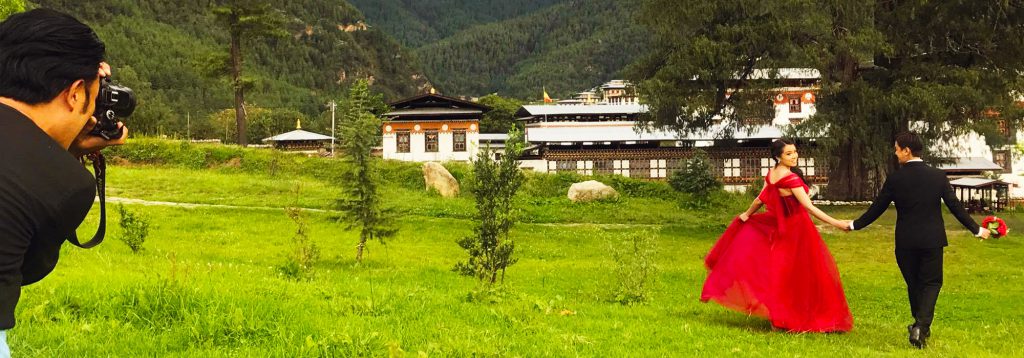
Spirituality exists in everyday life of Bhutanese people, therefore in Bhutan a wedding is a celestial union of mind, body and soul of two people. Bhutan has became one of the most popular wedding country now, with celebrities and some of the most popular people visiting Bhutan to have their blessed wedding vows in Bhutan.
One of the most renowned person who got proposed and got married in Bhutan is Dew Aung San Su kyi at Tigers nest temple, Hong kong celebrities Carina Lau and Tony Leung Chiu Wai and the list goes on.
Wedding Location : Wedding can be an ancient temple temple ( 1000 year sold sacred temple/shrine ), Resort in or 300 years old heritage Bhutanese home.
Location tours: Thimphu (capital ), Paro valley and Punakha valley.
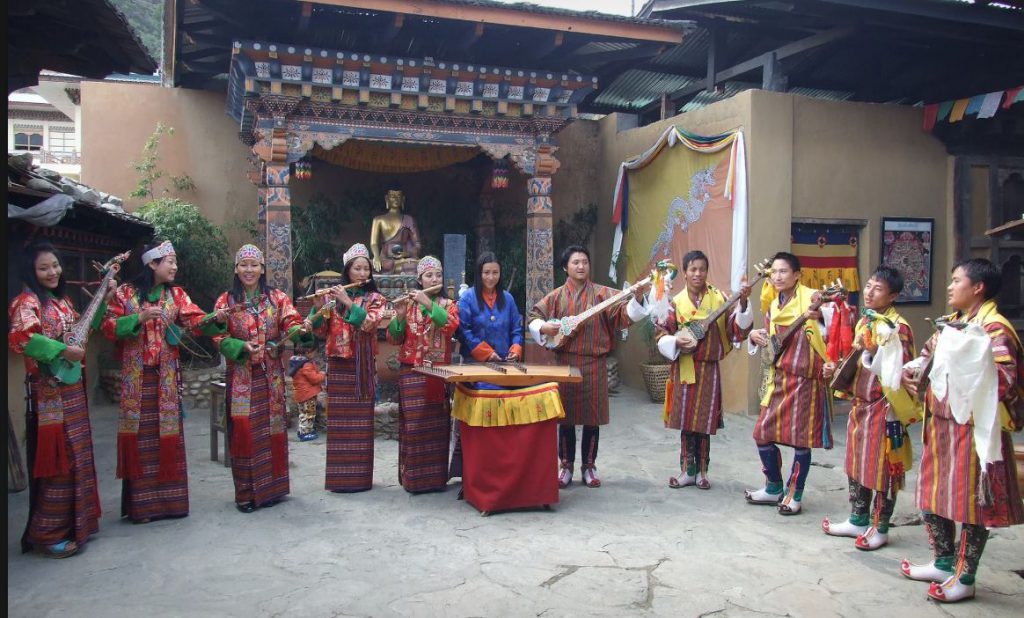
Fly into Paro, the great snow-capped peaks of the inner Himalayas rise up to the heavens can be seen during clear weather. As the plane approaches Bhutan, if you look down farmhouses as dots on the hillsides can be seen.
As the aircraft enters the Paro valley, you will see Paro Dzong on the hillside overlooking the Paro Chu (river), with Ta Dzong, formerly a watch tower and now the National Museum, above it.
You will be received by the representative of Bhutan, who will be your Bhutan travel guide throughout your tour.
Visit the following:
Overnight at a hotel in Thimphu.
After breakfast Thimphu sightseeing’s includes the following:
After 5 PM we will visit the Tashichho Dzong, “the fortress of the glorious religion”.
This is the centre of government and religion, site of the monarch’s throne room and seat of the Je Khenpo or Chief Abbot. Built in 1641 by the political and religious unifier of Bhutan, Shabdrung Ngawang Namgyal, it was reconstructed in the 1960s in traditional Bhutanese manner, without nails or architectural plan.
Night halt in Thimphu.
Today we will dress up the couple in exotic Bhutanese costumes and prepare them for the wedding. We will then drive to one of the holiest shrines in Thimphu and make the vow arrangements;
The Head monk will preside over the rituals and offer the scarves to the couples. “Bhutanese wedding is much more than an exchange of vows and rings.
It includes a number of religious rites performed by Buddhist monks and lamas. This represents the importance of the bond between two people. This ceremony is also used for renewing marriage vows.
The actual wedding ceremony and blessings for a lifetime of love and happiness takes place at home. This is followed by visits to sacred temples to make more offerings.
Lhabsang purification : The ceremony begins with a ritual in the morning performed by the monks before arriving at the temple.
Butter lamp : Butter lamps are lit inside the temple as an offering to the deities. Before lighting the lamps the bride and groom have to prostate six times; three times to the head monk and three times to the main alter.
Thrisor : Thrisor is a rite of purification and cleansing that is performed by the head monk at the temple. This will clear your bodies, minds, and speech of all past sins
During the ceremony, monks recite mantras and offer fumigation outside the temple to please the local deities. Bhutanese believe that only if the local deities are pleased we can have their blessing and enjoy good health and wealth.
The fumigation is to please their sense of smell and grains added to the fumigation are to quell their hunger. Inside the temple butter lamps are lit and prostrations done. The butter lamps are an offering of light to deities and the most common means of increasing merit.
Changphoe : The offering to the gods and deities in a form of liquor. After an offering is made to the deities, the liquor (ara) will then be served to the bride and the groom in a traditional wooden phop. (cup), which they will share. This symbolises the faith and everlasting bond the husband and the wife will share for the rest of their lives.
Tsephamey Choko : Tsephamey Choko is a long ritual that is performed in honor of Tsepamey; the God of longevity. It is performed by the head monk to give you a long and happy life together. It is followed by the bride and groom being blessed by the head monk.
Zhugdrey Phunsum Tshogpa : Food and drinks are now offered to deities and the people at the ceremony. This represents unity, wealth, and glory, and in no way should be refused. Normally oranges are used, as they are attractive, taste good, and represent unity. As well, the actual fruit is protected under a layer of skin, which symbolizes security and protection.
Dhar Nayanga : This is the last part of a Bhutanese wedding. Five colored scarves are given to the bride and groom as well as wishes for a happy, prosperous, and everlasting marriage
In addition to these traditions, the bride and groom should be wearing traditional Bhutanese costumes to show respect for this sacred ceremony. This means that the bride will wear a Kira and the groom will wear a Gho.
Option: After the wedding we will drive to the Bhutan post office and take photo to make Stamps of the wedding, which us usable in any part of the world.
We will be driving to some of the best spots in Capital (Temples, mountain side and other beautiful landscapes to take photo of the couple who will be dressed colorfully.
In the evening we will have dinner in one of the Heritage Farmhouse/or simply Bhutan restaurant in Thimphu and also a private 1 hour cultural program will be organized for the married couple.
The beautiful day will finish with great Bhutanese authentic food and traditional Bhutanese Ara/Wine.
Overnight in Thimphu.
Sightseeing and Photo shoot at the Dochula Mountain pass (Half day photo shoot )
After breakfast, travel to Punakha through Dochula Pass (3,088m/10,130ft). If you have a clear sky, the view of the Himalayan Mountain ranges spectacular and you can even see the Gasa Dzong as a white dot in the horizon.
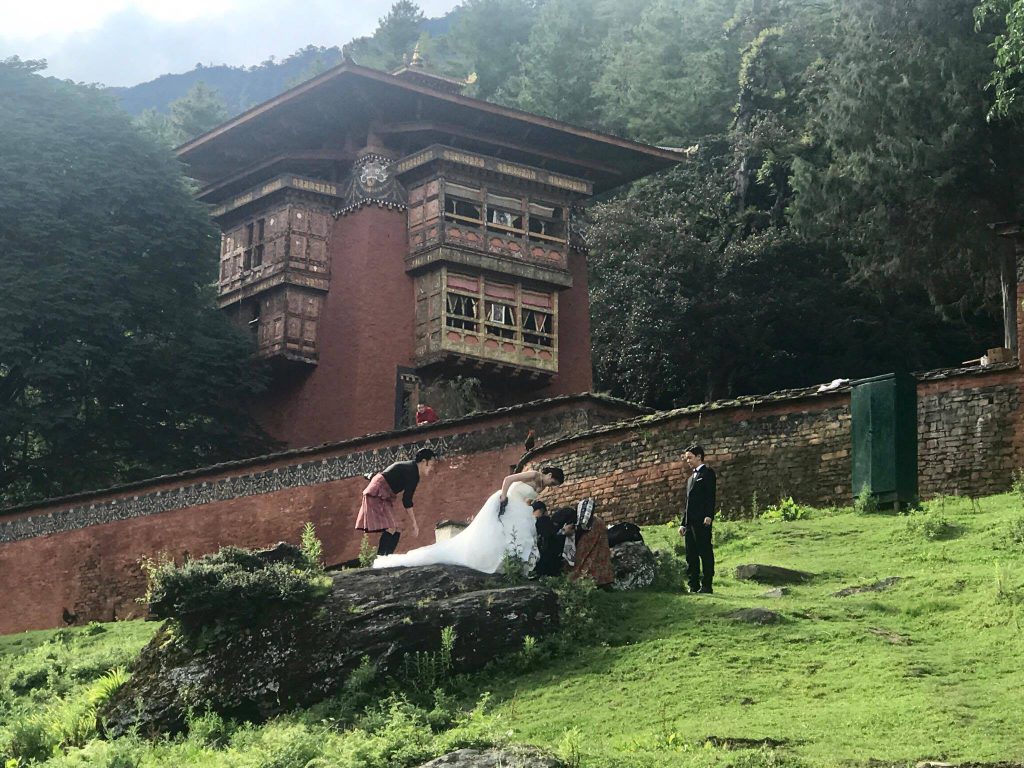
Visit the beautiful 108 chortens built on the hill by Her Majesty Ashi Dorji Wangmo for the security and well being of His Majesty the King of Bhutan.
Travel onto Punakha, the old capital of Bhutan and presently the winter residence of the central monk body.
Visit the Punakha Dzong, located on the island of the Pho – Chu (male) river and the Mochu (female) river. Evening, walk through the Metshina Village and take a 20 minute walk through the rice fields to the Devine Madman’s Monastery-Chhimi Lhakhang, famously known for its fertility shrine, where one can receive a special fertility blessing .
Overnight at a hotel in Wangdue/Punakha.
After breakfast, we will drive to Paro. Visit Kichu temple, one of the 108 temples built in the 7th century by the Tibetan King Songsten Gampo.
The story goes that a giant demon lay across the whole area of Tibet and the Himalayas and was preventing the spread of Buddhism. To overcome her King Songtsen Gampo decided to build 108 temples, which would be placed on all the points of her body. Of these 108 temples, 12 were built in accordance with precise plans.
Thus, it happened that in about the year 638 AD the temple of Jokhang in Lhasa was built over the very heart of the demon.
In the afternoon stop in Paro town and visit some of the popular coffer house and relax.
Night halt in Paro
After breakfast, drive up to the base camp of Taktsang and then hike up to the most famous Monastery in the entire kingdom of Bhutan perched on the edge of a steep cliff, about 900 meters above Paro Valley. The hike to the viewpoint will take about an hour and it will take 2 hours to the monastery.
Lunch at the viewpoint or at Paro town. Later sightseeing in town and Kichu Lhakhang. The 1300 years old Jo Jampa Temple. Overnight at a hotel in Paro.
In the morning, your tour guide from Yelha Bhutan Tours & Travels (local Bhutan travel agent) will escort you to Paro International Airport for your
departure.
—————————————————
Duration: 14 Days, 13 Nights.
Locations: Thimphu, Paro valley, Punakha, Wangdi Phodrang, Bumthang, Mongar,Takila, Tashiyangtse, Yonphula, Yonphula, Phobjikha
Type of Tour: Cultural tour/Adventure.
Highlight: Visit to the Ta Dzong (National Museum), Punakha Dzong, Worlds tallest bronze Buddha statue, Tigers nest hike, Phobjikha Valley, textile tour, east bhutan, Himalayas tallest Guru rimpoche statue, spiritual tour….
Fly into Paro on our national carrier, Druk Air, is a befitting introduction to the spectacular beauty of our country. In clear weather, magnificent views of the world’s highest peaks give way to the lush green Paro valley as you land. First gift from Bhutan will be the cool, clean fresh air as you step out of the plane.
After clearing customs and visa control you will meet our guide and driver.
In the afternoon visit Ta Dzong, once a watchtower, built to defend Rinpung Dzong during inter valley wars of the 17th century, Ta Dzong was inaugurated as Bhutan’s National Museum in 1968.
Afterwards, walk down a hillside trail to visit Rinpung Dzong. Built in 1646 by Zhabdrung Ngawang Namgyal, the first spiritual and temporal ruler of Bhutan, the Dzong houses the monastic body of Paro, the office of the Dzongda (district administrative head) and Drangpoen (judge) of Paro district.
Overnight in Paro.
As per the flight timing, you will be escorted to Paro International airport for the onward departure to Yonphula (Eastern Bhutan) via domestic flight. Guide and driver will receive you from the domestic airport, Yonphula and then enjoy the beautiful view from there. After that drive to Tashigang, one of the biggest district in Bhutan.
Check into the hotel and then visit Tashigang dzong, the fortress which was built in 17th century and has commanding view of the valley. Inside are few interesting temples and local government offices.
(If you arrive early in Tashigang, then drive to Rangjung for the sightseeing).
After the breakfast, drive to Tashiyangtse which will take about 2 hours’ drive time. On the way, visit to the Gomphu Kora temple, place where 8th century magician-saint Guru Padmasambhava left his body imprints. Further drive will offer occasional views of Snowy Mountain in clear weather.
Finally you will see impressive building of the old Trashi Yangtse dzong which is home to 300 monks. The dzong used to protect former trade route with Tibet and was established by the saint Pema Lingpa of 15th century.
The temples with valuable statues are worth of exploring. Also near the Trashi Yangtse is the famous Chorten Kora, the largest stupa in Bhutan built in Nepali style. This is the site of two colorful local festivals at the beginning of the year. Trashi Yangtse is also home to National Institute for Zorig Chusum, the school where the young people learns the art crafts of their forefathers to keep Bhutan’s traditional arts alive.
Evening return to Trashigang.
After breakfast, you will drive to Mongar which will take 31⁄2 hours’ drive but on the way, you can visit Dramtse Gompa, which is one of the most important monasteries of eastern Bhutan.
This is the place from where the famous Naga Chham (mask dance of the drums from Drametse), mask dance with drums originated. This dance is ubiquitous feature of many festivals and also it was included to the UNESCO list of oral and intangible heritage. Monastery itself was founded in 16th century by descendants of the saint Pema Lingpa and its name means “the peak where there is no enemy”.
There is number of interesting chapels with a lot of important statues of the saints and protector deities. After that drive to Mongar and on the way visit Ngatshang monastery. You will also stop for a coffee at Korila pass between before reaching Mongar. After reaching Mongar, you will visit a dzong (castle). Although built in 1930, the dzong maintains Bhutanese architectural traditions.
Morning drive to Lhuntse which is one of the most rural and isolated districts in Bhutan. The landscape is spectacular with stark cliffs and gorges, beautiful conifer and pine forests and remote villages with rice, millet and corn fields.

Kurtoe region of Lhuntse is the ancestral home of Bhutan’s royal family. We will visit Takila, the place where the gigantic statue of Guru Rimpoche was recently built. Inside the statue, you find number of richly decorated chapels, which.
Further you will continue to Khoma village for most elaborate traditional cloths in Bhutan. Quality of weaving is so fine that even Royal Family places their order for clothes here. Village itself is interesting and beautiful so we will spend some extra time here having a lunch in local house and tasting local delicacies.
Then drive back to Mongar for overnight.
The journey continues westwards winding through more rugged terrain. The drive will take minimum 7 hours, but it won’t be boring at all. Road offers most spectacular views in the country ascending 3200 meters in the distance of 84 kilometers.
After about a hour drive, you’ll pass along the ruins of Sengor dzong, which burned to ash in 1899. Chortens on the roadside are built in memory of 300 laborers who died during road building in 1970’s.
You’ll also come along the stunning Namling waterfall. After crossing the second highest motor able pass in Bhutan, the Thrumshing-la (3,580 m), you gradually descend to clustered village of Ura.
It’s good idea to stop at rhododendron garden just after the pass to see the number of species of this beautiful tree. From Ura village we will continue drive to the Shertong-la pass (3580 m). Right after that in sharp turn,
the Gangkhar Punesum, the highest mountain in Bhutan might be seen in clear weather.
Overnight at hotel in Bumthang.
After lunch, we will visit the following:
Overnight at Bumthang
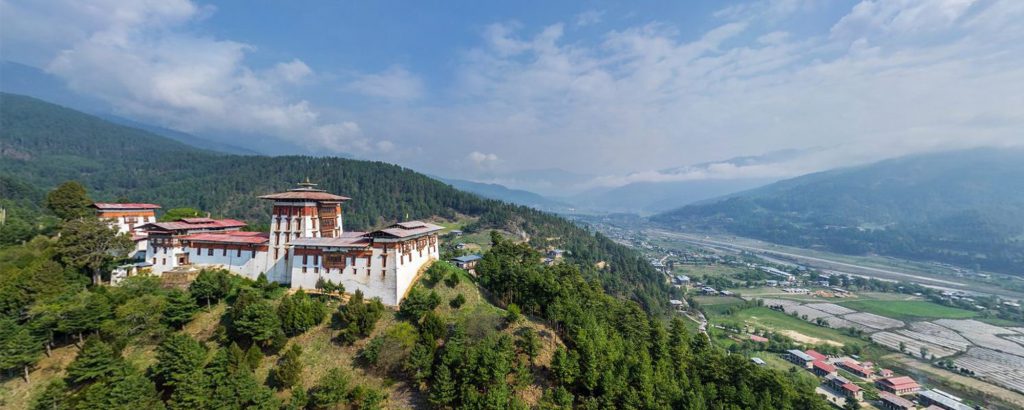
After breakfast, drive to Wangdue/ Punakha via Phobjikha valley. Driving through the dense forests of the Phobjikha Valley you arrive at Gangtey village where you see the Gangtey Monastery and visit the monastery.
Phobjikha valley is part of the beautiful Jigme Singye Wangchuck National Park (formerly known as Black Mountains National Park), one of Bhutan’s most important nature sanctuaries.
Each winter it is home to a flock of 300 rare and endangered black-necked cranes. The surrounding hills and mountains are home to nomadic shepherds and yak-herders. After lunch at Gangtey and explore Phobjikha valley and also visit the Black Necked Crane Center.
Dinner and overnight at Gangtey valley with natural view.
Today after breakfast we will drive to Punakha valley with sightseeing en-route. We will stop at certain places for tea/refreshments and drive slowly towards Punakha valley.
Punakha was the winter capital for over 300 years until the time of second King. Punakha Dzong, which dominates the whole area, was built in 1637 by Zhabdrung Ngawang Namgyel, and established the central monastic body with 600 monks.
Visit Punakha suspension bridge. Punakha suspension Linking Punakha Dzong to Shengana, Samdingkha, and Wangkha villages across the Tsang Chu River (aka Po Chu), this is one of the longest suspension bridges in Bhutan.
It is roughly 160 meters long suspension bridge, it’s surprisingly stable. The bridge offers a spectacular view of the river and valley, and the east bank is a good starting point for multi-day treks in the nearby mountains.
Overnight Punakha at Hotel.
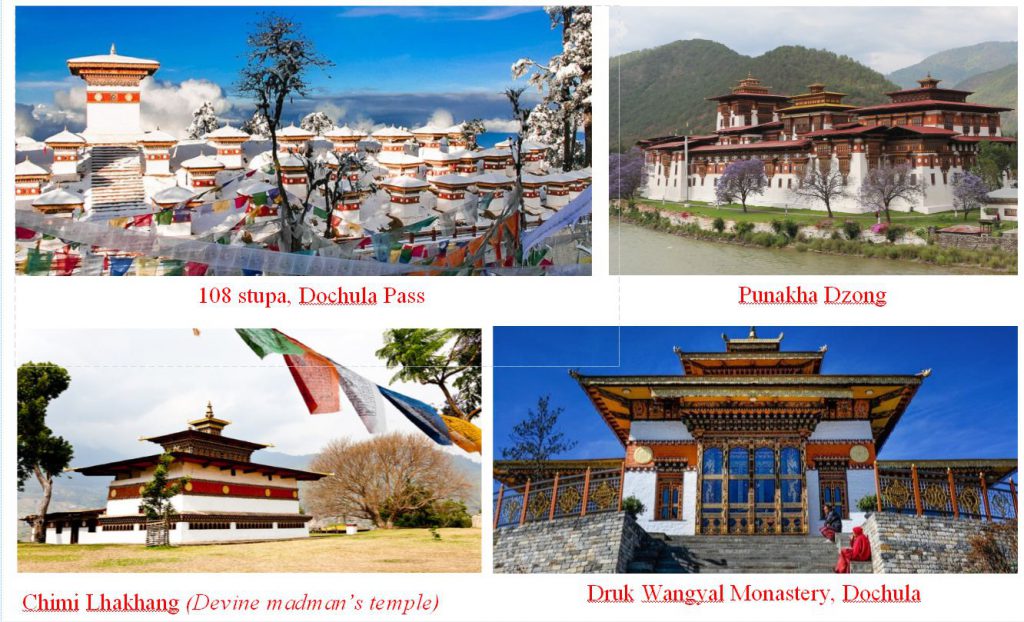
After breakfast, we will drive through upper Punakha valley passing through farm houses and take a leisure walk through farmhouses to the beautiful Khamsum Yuelley Namgyal Lhakhang (temple) built by Ashi Tshering Yangdon Wangchuck (the Queen Mother of Bhutan) for peace and stability in this ever changing world.
The leisurely walk up to the temple would take about an hour.
After lunch, we will travel to Thimphu and on the way we will visit Devine Madman’s temple (Chimi Lhakhang). Before arriving in Thimphu you come across Dochula (Dochula Pass 3140m).
In the clear sky, enjoy the panoramic view of Himalayan Mountain ranges. Then pass by the beautiful 108 chortens (Stupa) built on the hill by Her Majesty Ashi Dorji Wangmo Wangchuck (Queen Mother of Bhutan) for the security and well being of His Majesty, the King of Bhutan.
Overnight at Punakha.
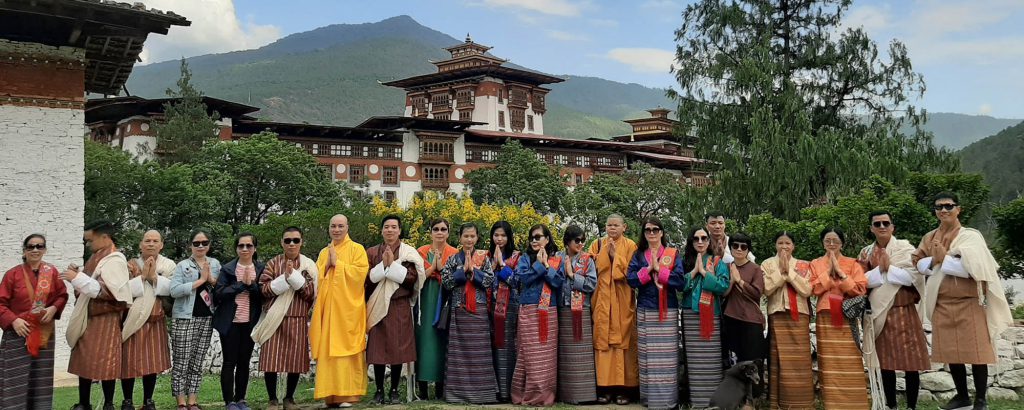
After breakfast visit Kuensel phodrang (commonly known as Buddha Point) where the largest Buddha statue in the country is perched on the hillock overlooking the Thimphu Valley. You may take a nature hike through Kuensel Phodrang Nature Park.
Then visit, National Memorial Chorten (stupa) which was constructed in 1974 as a memorial for the third King of Bhutan, King Jigme Dorji Wangchuck. After lunch visit the following:
Dechenphodrang (meaning, Palace of great bliss) Monastery located at north of Thimphu valley. It is a monastic school for about 500 young monks enrolled for 8 years courses.
You will visit the monastery and have free interaction with young monks who are mostly from poor family ground and some even orphan. The “Palace of Great Bliss‟ serves as a home and learning center for these young monks. You will spend some time interacting with young monks.
Tashichhoe Dzong, a fortress of the glorious religion. It was built in 1641 by Zhabdrung Ngawang Namgyel and was reconstructed into present structure by the late King, His majesty Jigme Dorji Wangchuck in the year 1962-1969. It houses the secretariat building, the throne room and the office of the king, and the central monk body.
Centenary farmer’s market where the farmers/locals sells their organic farm produces.
Overnight at Thimphu.
Have breakfast in hotel and then visit the following:
After lunch, visit weaving Center at Changzamtog and continue with the drive to Paro.
Check into the hotel and then visit small Paro town for shopping if you wish. Overnight at Paro.
After breakfast, drive up to the base camp of Taktsang and then hike up to the most famous Monastery in the entire kingdom of Bhutan perched on the edge of a steep cliff, about 900 meters above Paro Valley.
The hike to the viewpoint will take about an hour and it will take 2 hours to the monastery. Till view point, you can experience horse ride by paying USD 15 to USD 20 per horse but if you prefer hike, then it is great.
Lunch at Taktshang Café just above view point or you can have picnic lunch.
After completing the hike, you will be visiting one of the farm houses in Paro to experience Bhutanese life-Style and the organic Bhutanese dinner.
You can also experience hot-stone bath at farm house (US $ 20 /25per person).
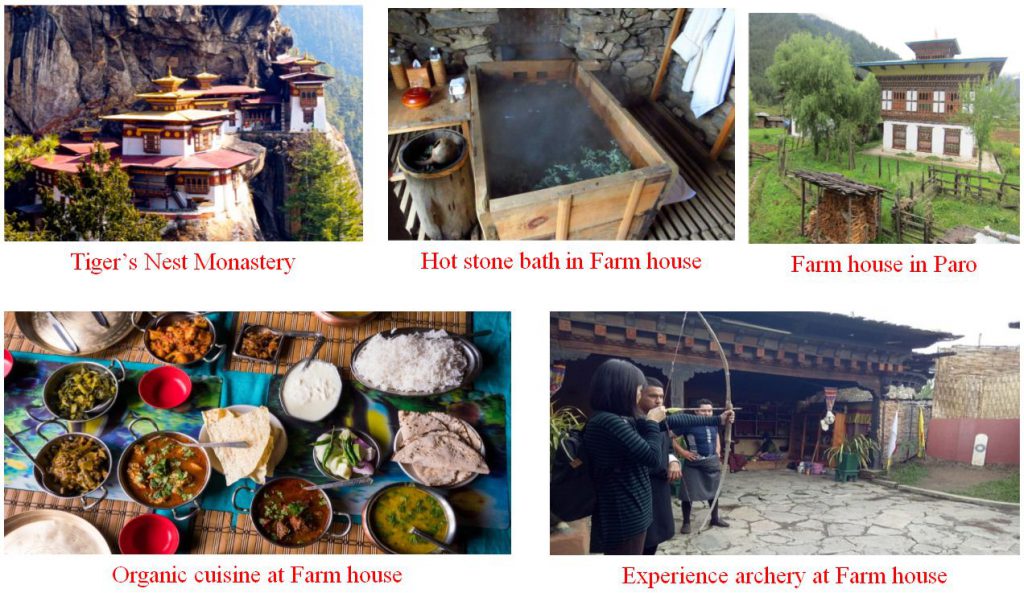
In the morning, your tour guide from Yelha Bhutan Tours & Travels (local Bhutan travel agent) will escort you to the airport for your onward destinations.
Duration: 10 Days, 9 Nights.
Locations: Thimphu, Paro valley, Punakha, Bumthang.
Type of Tour: Organic farming/Cultural tour/Adventure.
Highlight: Visit to Ura valley, take part in matsutake mushroom festival, visit central Bhutan, the Ta Dzong (National Museum), Punakha Dzong, Worlds tallest bronze Buddha statue, Tigers nest hike, Gangtey Gompa sightseeing, Bumthang valley.
Description: The most favored and the most expensive Mushroom in the World. Costing almost USD$ 2000 per kg in Japan.
The fabled wild Matsutake mushrooms of Bhutan. Prized by gourmets in Japan, this fungi is native to the forests of Ura valley in central Bhutan.
Ura valley is renowned for being one of the most picturesque valleys in the entire kingdom. Its inhabitants, the Uraps are a cheerful, hospitable people. Ura provides one of the most authentic experiences of traditional rural Bhutanese life available. At the festival, visitors learn to identify these fabled mushrooms as they embark on mushroom picking excursions around the pristine forests and hills.
They’ll be able to sample delicious Matsutake recipes, engage in songs and dances together with the locals, hike through the stunning Himalayan landscape and even relax in traditional open-air mineral baths –